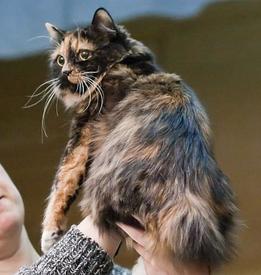
Its name, meaning “Wales” in Gaelic, describes a cat that initially evolved on the Isle of Man where tailless kittens were born to native cats. Despite its name, the Cymric has no Welsh connections and it is thought the title was adopted in an attempt to offer something ‘Celtic-sounding’ to the breed. It is widely believed that the Cymric is merely a longhaired variety of the Manx breed, although some consider it completely separate. Whilst initially rejected as a mutant, longhaired, tailless cat, the Cymric eventually gained favour and was selectively bred to retain its unique characteristics.
A medium-sized cat of strong, athletic build, the Cymric is a popular domestic pet due to its handsome appearance and amiable temperament. In terms of its physical appearance, the Cymric possesses a sturdy frame, with long legs, wide-spaced ears and a general rounded look – with a rounded head and rear-end. The long hair is quite possibly another genetic mutation in the breed and is typically profuse, silky and is observed in a variety of colours. The most commonly seen are calico, tortoiseshell, tabby, and solid colours without patterning. The Cymric is characterised by a stumpy tail, or by a lack of tail, which is usually hidden beneath the dense fur.
Like its shorthaired cousin the Manx, the Cymric is a highly intelligent breed that is devoted to its human family and enjoys being involved in activities around the home. Some owners and breeders have described the cat as being aloof at times, and not as demanding of attention as other feline breeds. Besides this, the Cymric is spritely, energetic and easily trainable. It is compatible with other house pets and children, making it a great breed choice for young families. Never unduly shy or aggressive, the Cymric makes a delightful addition to any home setting! Typically, a healthy Cymric will weigh 7-14 pounds, with an average life expectancy of 15 years.
The tailless trait is not always completely harmless but often corresponds to a severe spinal problem. Spina Bifida, fused or incomplete vertebrae, and bladder or bowel dysfunction are just some of the health issues prevalent in this breed. Some of these spinal afflictions can have a neurological effect, while others result in toileting and mobility problems. When purchasing a Cymric kitten it is worth waiting until he/she is six months old to determine whether it is going to suffer from any of these problems.
Do you own a Cymric? Let others know what they're like!
Related products
Advantage 80 Spot On Flea Control Large Cats and Rabbits
from £12.95
Advantage 40 Spot On Flea Control Cats, Small Dogs and Rabbits
from £12.95
Advantage 100 Spot On Flea Control Medium Dog
from £12.95
Advantage 250 Spot On Flea Control Large Dog
from £12.95
Drontal Tasty Bone Wormer Tablets for Small & Medium Dogs (2 to 20kg)
from £2.15
FRONTLINE Plus Flea & Tick Treatment Dogs & Cats
from £17.49
TermaWorm™ Tablets for Cats & Dogs
from £1.59
Drontal Tasty Bone XL Wormer Tablets for Large Dogs (Over 20kg)
from £6.39